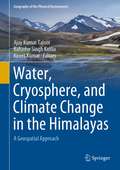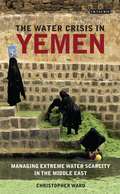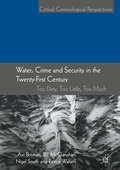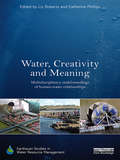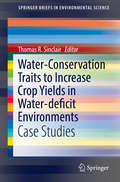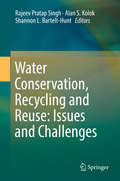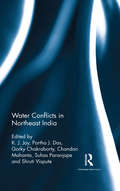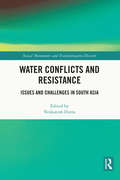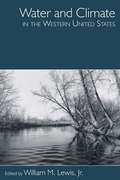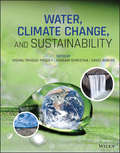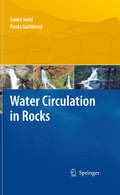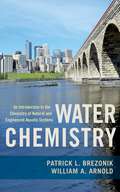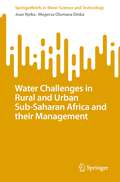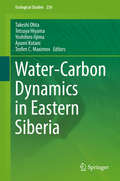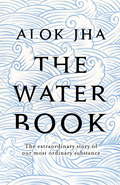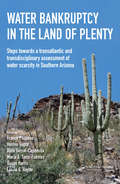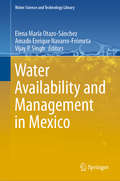- Table View
- List View
The Water Cycle (UEB Uncontracted)
by Rnib BookshareThe image shows the sky, a cross section through land, and the sea. There is a locator dot shown, which will be at the top left when the image is the correct way up. The diagram is labelled and arrows show the direction of the water flow and the sun's heat. There is a rain cloud in the top left corner of the image. An arrow labelled â œprecipitationâ leads down to the start of a stream which flows right into a lake. Water from the lake flows right into a river, which flows right into the sea. An arrow labelled â œevaporationâ leads up from the sea, and back left to the rain cloud to complete the cycle. In the top right of the page a heavy arrow pointing down is labelled â œsunâ TMs heatâ , which is the cause of the evaporation. In the centre left there is an arrow pointing down which shows water percolating through the land. A rock layer labelled â œimpervious rock layerâ stops the water percolating further down, so it flows to the right towards the sea. In the centre right of the page an upward-pointing arrow shows transpiration from plants. This water vapour joins the evaporation from the sea and moves left to the rain cloud.
The Water Cycle (UEB Contracted)
by Rnib BookshareThe image shows the sky, a cross section through land, and the sea. There is a locator dot shown, which will be at the top left when the image is the correct way up. The diagram is labelled and arrows show the direction of the water flow and the sun's heat. There is a rain cloud in the top left corner of the image. An arrow labelled â œprecipitationâ leads down to the start of a stream which flows right into a lake. Water from the lake flows right into a river, which flows right into the sea. An arrow labelled â œevaporationâ leads up from the sea, and back left to the rain cloud to complete the cycle. In the top right of the page a heavy arrow pointing down is labelled â œsunâ TMs heatâ , which is the cause of the evaporation. In the centre left there is an arrow pointing down which shows water percolating through the land. A rock layer labelled â œimpervious rock layerâ stops the water percolating further down, so it flows to the right towards the sea. In the centre right of the page an upward-pointing arrow shows transpiration from plants. This water vapour joins the evaporation from the sea and moves left to the rain cloud.
The Water Cycle (Large Print)
by Rnib BookshareThe image shows the sky, a cross section through land, and the sea. There is a locator dot shown, which will be at the top left when the image is the correct way up. The diagram is labelled and arrows show the direction of the water flow and the sun's heat. There is a rain cloud in the top left corner of the image. An arrow labelled â œprecipitationâ leads down to the start of a stream which flows right into a lake. Water from the lake flows right into a river, which flows right into the sea. An arrow labelled â œevaporationâ leads up from the sea, and back left to the rain cloud to complete the cycle. In the top right of the page a heavy arrow pointing down is labelled â œsunâ TMs heatâ , which is the cause of the evaporation. In the centre left there is an arrow pointing down which shows water percolating through the land. A rock layer labelled â œimpervious rock layerâ stops the water percolating further down, so it flows to the right towards the sea. In the centre right of the page an upward-pointing arrow shows transpiration from plants. This water vapour joins the evaporation from the sea and moves left to the rain cloud.
Water, Cryosphere, and Climate Change in the Himalayas: A Geospatial Approach (Geography of the Physical Environment)
by Ajay Kumar Taloor Bahadur Singh Kotlia Kireet KumarThis edited book summarizes numerous research studies on remote sensing and GIS of natural resource management for the Himalaya region done by Indian Institutions and Universities over the last decade. It gives an overview of hydrometeorological studies on Himalayan water resources and addresses concerns in the development of water resources in this region, which is dealing with an increased pressure in population, industrialization and economic development. While the source of some of the major rivers of India are found in the Himalayas, the glaciers and water bodies in the region are continuously shrinking leading to a depletion of water and deterioration of water quality. This is affecting a population of up to 2.5 billion people. The ecosystems have been under threat due to deforestation, loss of biodiversity, expansion of agriculture and settlement, overexploitation of natural resources, habitat loss and fragmentation, poaching, mining, construction of roads and large dams, and unplanned tourism. Spaceborne remote sensing with its ability to provide synoptic and repetitive coverage has emerged as a powerful tool for assessment and monitoring of the Himalayan resources and phenomena. This work serves as a resource to students, researchers, scientists, professionals, and policy makers both in India and on a global level.
The Water Crisis in Yemen: Managing Extreme Water Scarcity in the Middle East (International Library of Human Geography)
by Christopher WardSince the 1970s Yemen has undergone rapid social and economic change. But the creation of the modern state has come at a cost, and the country has fallen into a severe water crisis. Groundwater is being extracted at such a rate that parts of the rural economy could disappear within a generation. In no other country in the Middle East are the aquifers being exhausted so quickly. Christopher Ward provides the first comprehensive study of the water management crisis in Yemen and presents a complete analysis, covering the institutional, environmental, technical and political economy components. He assesses the social and economic impacts of the crisis and provides in-depth case studies in the key management areas: water resources management; agricultural water management and irrigation; urban water supply and sanitation; and rural water supply and sanitation. He examines the range of policy and programme responses to date and explores their largely unsuccessful outcomes. In the final part of the book the author evaluates the current strategy and looks at future ways in which the people of the country and their government can influence outcomes and make the transition to a sustainable water economy. Combining a historical perspective and an interdisciplinary approach, The Water Crisis in Yemen draws on both new field research and a very wide set of official and unofficial information sources, much of it being made available for the first time. The result offers a comprehensive, practical and effective approach to achieving sustainable and equitable water management in a country whose water problems are amongst the most serious in the world.
Water, Crime and Security in the Twenty-First Century: Too Dirty, Too Little, Too Much (Critical Criminological Perspectives )
by Avi Brisman Nigel South Reece Walters Bill McClanahanCritical Criminological Perspectives Ser.
Water, Creativity And Meaning: Multidisciplinary Understandings Of Human-water Relationships (Earthscan Studies In Water Resource Management Ser. (PDF))
by Katherine Jones Elisabeth RobertsAt a time of great turmoil and crisis, environmentally, socially and politically, water has emerged as a topic of huge global concern. Moreover, many argue that what is needed in order to change our relationship with the environment is a cultural paradigm shift. To this end, this volume brings together diverse approaches to exploring human relationships with the watery world and the other living things that rely upon it. Through exploring multiple creative ways of engaging with water and people, the volume adds to the current zeitgeist of writing about water by expanding the discussion about this vital substance and how, as humans, we relate to it. Chapters focus on creative explorations and explorations of creativity in relation to developing these understandings, including concepts such as hydrocitizenship and responses to drought and flooding. Drawing on the in-depth research and experience of arts practitioners including participatory artists, as well as academics from a variety of fields including geography, anthropology, health studies and environmental humanities, the book provides a rich and multidisciplinary perspective on water and creative ways of engaging and understanding human–water relationships. It represents a valuable source and inspiration for academics, arts practitioners and those involved in environmental policy and governance.
Water, Creativity And Meaning: Multidisciplinary Understandings Of Human-water Relationships (Earthscan Studies In Water Resource Management Ser. (PDF))
by Katherine Jones Elisabeth RobertsAt a time of great turmoil and crisis, environmentally, socially and politically, water has emerged as a topic of huge global concern. Moreover, many argue that what is needed in order to change our relationship with the environment is a cultural paradigm shift. To this end, this volume brings together diverse approaches to exploring human relationships with the watery world and the other living things that rely upon it. Through exploring multiple creative ways of engaging with water and people, the volume adds to the current zeitgeist of writing about water by expanding the discussion about this vital substance and how, as humans, we relate to it. Chapters focus on creative explorations and explorations of creativity in relation to developing these understandings, including concepts such as hydrocitizenship and responses to drought and flooding. Drawing on the in-depth research and experience of arts practitioners including participatory artists, as well as academics from a variety of fields including geography, anthropology, health studies and environmental humanities, the book provides a rich and multidisciplinary perspective on water and creative ways of engaging and understanding human–water relationships. It represents a valuable source and inspiration for academics, arts practitioners and those involved in environmental policy and governance.
Water-Conservation Traits to Increase Crop Yields in Water-deficit Environments: Case Studies (SpringerBriefs in Environmental Science)
by Thomas R. SinclairThis volume explores specific approaches that have shown to result in crop yield increases. Research on the physiological understanding of these methods has led to the development of practical applications of plant breeding approaches to genetically improve crops to achieve higher yields. Authoritative entries from crop scientists shed new light on two water-conservation traits: one that is based on an initiation of the decrease in transpiration earlier in the soil drying cycle, and the second that is based on a sensitivity of transpiration rate under high atmospheric vapor pressure deficit that results in partial stomatal closure. Both these approaches involve partial stomatal closure under well-defined situations to decrease the rate of soil water loss. Readers will be able to analyze the circumstances under which a benefit is achieved as a result of the water-limitation trait; and key discussion points in the case studies presented will help answer questions such as what species, which environments, how often will yield be benefited for various crop species? Contributions also review the genetic variation for these two traits within each crop species and the physiological basis for the expression of these traits.
Water Conservation, Recycling and Reuse: Issues and Challenges
by Rajeev Pratap Singh Alan S. Kolok Shannon L. Bartelt-HuntWater - a basic element of life, livelihood, food security and sustainable development - holds the key to global sustainability. The global water demand has been increased 3-fold in the past five decades and only 0.4% of the total world’s fresh water resources is available and accessible for use. The United Nations projected that half of all countries will face water scarcity by 2025 and more than one-third of the world’s population could be affected by water stress by 2050. The water problem is rapidly intensifying in the Asian region, and around 700 million people do not have access to safe drinking water. Similarly, according to the Intergovernmental Panel on Climate Change (IPCC) report, by 2050, more than one billion people in Asia alone are projected to experience negative impacts on water resources as a result of climate change. Climate change is also putting extra pressure on and adversely affecting the global water cycle, leading to irregular precipitation, more floods and droughts and creating an imbalance between water supply and demand. The availability of safe water is a major global concern due to the rapidly increasing population, urbanization, unsustainable consumption patterns, and rapid shifts in land use. It is believed that reduced access to freshwater will have cascading consequences that will pose threat to global food security, livelihood security, and cause large scale migration and economic and geopolitical tensions. As such, strategies for water conservation, wastewater reuse and recycling should be adopted in order to lessen the gap between supply and demand for water for different activities. This book provides readers with a better understanding of the water security challenges, and presents innovations to address these challenges, strengthen the science-policy interface, and develop institutional and human capacities for water security and sustainability.
Water Conflicts in Northeast India
by K. J. Joy Partha J. Das Gorky Chakraborty Chandan Mahanta Suhas Paranjape Shruti VisputeNortheast India, apart from being the rainiest in India, is drained by two large river systems of the world – the Brahmaputra and the Barak (Meghna) – both transnational rivers cutting across bordering countries. The region, known for its rich water resources, has been witnessing an increasing number of conflicts related to water in recent years. This volume documents the multifaceted conflicts and contestations around water in Northeast India, analyses their causes and consequences, and includes expert recommendations. It fills a major gap in the subject by examining wide-ranging issues such as cultural and anthropological dimensions of damming rivers in the Northeast and Eastern Himalayas; seismic surveys, oil extractions, and water conflicts; discontent over water quality and drinking water; floods, river bank erosion, embankments; water policy; transboundary water conflicts; and hydropower development. It also discusses the alleged Chinese efforts to divert the Brahmaputra River. With its analytical and comprehensive coverage, 18 case studies, and suggested approaches for conflict resolution, this book will be indispensable for scholars and researchers of development studies, governance and public policy, politics and international relations, water resources, environment, geography, climate change, area studies, economics, and sociology. It will also be an important resource for policymakers, bureaucrats, development practitioners, civil society groups, the judiciary, and media.
Water Conflicts in Northeast India
by K. J. Joy Partha J. Das Gorky Chakraborty Chandan Mahanta Suhas Paranjape Shruti VisputeNortheast India, apart from being the rainiest in India, is drained by two large river systems of the world – the Brahmaputra and the Barak (Meghna) – both transnational rivers cutting across bordering countries. The region, known for its rich water resources, has been witnessing an increasing number of conflicts related to water in recent years. This volume documents the multifaceted conflicts and contestations around water in Northeast India, analyses their causes and consequences, and includes expert recommendations. It fills a major gap in the subject by examining wide-ranging issues such as cultural and anthropological dimensions of damming rivers in the Northeast and Eastern Himalayas; seismic surveys, oil extractions, and water conflicts; discontent over water quality and drinking water; floods, river bank erosion, embankments; water policy; transboundary water conflicts; and hydropower development. It also discusses the alleged Chinese efforts to divert the Brahmaputra River. With its analytical and comprehensive coverage, 18 case studies, and suggested approaches for conflict resolution, this book will be indispensable for scholars and researchers of development studies, governance and public policy, politics and international relations, water resources, environment, geography, climate change, area studies, economics, and sociology. It will also be an important resource for policymakers, bureaucrats, development practitioners, civil society groups, the judiciary, and media.
Water Conflicts and Resistance: Issues and Challenges in South Asia (Social Movements and Transformative Dissent)
by Venkatesh DuttaThis book presents a systematic study of transboundary, regional and local water conflicts and resistance across several river basins in South Asia. Addressing hydro-socio-economic aspects in competing water sharing and transfer agreements, as well as conflicting regimes of legal plurality, property rights and policy implementation, it discusses themes such as rights over land and natural resources; resettlement of dam-displaced people; urban–rural conflicts over water allocation; peri-urbanisation, land use conflicts and water security; tradeoffs and constraints in restoration of ecological flows in rivers; resilience against water conflicts in a river basin; and irrigation projects and sustainability of water resources. Bringing together experts, professionals, lawyers, government and the civil society, the volume analyses water conflicts at local, regional and transboundary scales; reviews current debates with case studies; and outlines emerging challenges in water policy, law, governance and institutions in South Asia. It also offers alternative tools and frameworks of water sharing mechanisms, conflict resolution, dialogue, and models of cooperation and collaboration for key stakeholders towards possible solutions for effective, equitable and strategic water management. This book will be useful to scholars and researchers of development studies, environment studies, water studies, public policy, political science, international relations, conflict resolution, political economy, economics, sociology and social anthropology, environmental law, governance and South Asian studies. It will also benefit practitioners, water policy thinktanks and associations, policymakers, diplomats and NGOs.
Water Conflicts and Resistance: Issues and Challenges in South Asia (Social Movements and Transformative Dissent)
by Venkatesh DuttaThis book presents a systematic study of transboundary, regional and local water conflicts and resistance across several river basins in South Asia. Addressing hydro-socio-economic aspects in competing water sharing and transfer agreements, as well as conflicting regimes of legal plurality, property rights and policy implementation, it discusses themes such as rights over land and natural resources; resettlement of dam-displaced people; urban–rural conflicts over water allocation; peri-urbanisation, land use conflicts and water security; tradeoffs and constraints in restoration of ecological flows in rivers; resilience against water conflicts in a river basin; and irrigation projects and sustainability of water resources. Bringing together experts, professionals, lawyers, government and the civil society, the volume analyses water conflicts at local, regional and transboundary scales; reviews current debates with case studies; and outlines emerging challenges in water policy, law, governance and institutions in South Asia. It also offers alternative tools and frameworks of water sharing mechanisms, conflict resolution, dialogue, and models of cooperation and collaboration for key stakeholders towards possible solutions for effective, equitable and strategic water management. This book will be useful to scholars and researchers of development studies, environment studies, water studies, public policy, political science, international relations, conflict resolution, political economy, economics, sociology and social anthropology, environmental law, governance and South Asian studies. It will also benefit practitioners, water policy thinktanks and associations, policymakers, diplomats and NGOs.
Water & Climate/Western U.S.
by W LewisWater and Climate in the Western United States highlights the opportunity for and necessity of change in management of water, the West's most crucial resource. As old policies and institutions fail to meet changing demands for and availability of w
Water, Climate Change, and Sustainability
by Vishnu Prasad Pandey Sangam Shrestha David WibergAn in-depth review of sustainable concepts in water resources management under climate change Climate change continues to intensify existing pressures in water resources management, such as rapid population growth, land use changes, pollution, damming of rivers, and many others. Securing a reliable water supply—critical for achieving Sustainable Development Goals (SDGs)—requires understanding of the relation between finite water resources, climate variability/change, and various elements of sustainability. Water, Climate Change, and Sustainability is a timely and in-depth examination of the concept of sustainability as it relates to water resources management in the context of climate change risks. Featuring contributions by global authors, this edited volume is organized into three sections: Sustainability Concepts; Sustainability Approaches, Tools, and Techniques; and Sustainability in Practice. Detailed chapters describe the linkage between water and sustainable development, highlight the development and use of new measuring and reporting methods, and discuss the implementation of sustainability concepts in various water use sectors. Topics include localizing and mainstreaming global water sustainability initiatives, resilient water infrastructure for poverty reduction, urban water security for sustainable cities, climate actions and challenges for sustainable ecosystem services, and more. This important resource: Reviews contemporary scientific research and practical applications in the areas of water, climate change and sustainability in different regions of the world Discusses future directions of research and practices in relation to expected patterns of climate changes Covers a wide range of concepts, theories, and perspectives of sustainable development of water resources Features case studies of field and modelling techniques for analyzing water resources and evaluating vulnerability, security, and associated risks Discusses practical applications of water resources in contexts such as food security, global health, clean energy, and climate action Water, Climate Change, and Sustainability is an invaluable resource for policy makers water managers, researchers, and other professionals in the field, and an ideal text for graduate students in hydrogeology, climate change, geophysics, geochemistry, geography, water resources, and environmental science.
Water, Climate Change, and Sustainability
by Vishnu Prasad Pandey Sangam Shrestha David WibergAn in-depth review of sustainable concepts in water resources management under climate change Climate change continues to intensify existing pressures in water resources management, such as rapid population growth, land use changes, pollution, damming of rivers, and many others. Securing a reliable water supply—critical for achieving Sustainable Development Goals (SDGs)—requires understanding of the relation between finite water resources, climate variability/change, and various elements of sustainability. Water, Climate Change, and Sustainability is a timely and in-depth examination of the concept of sustainability as it relates to water resources management in the context of climate change risks. Featuring contributions by global authors, this edited volume is organized into three sections: Sustainability Concepts; Sustainability Approaches, Tools, and Techniques; and Sustainability in Practice. Detailed chapters describe the linkage between water and sustainable development, highlight the development and use of new measuring and reporting methods, and discuss the implementation of sustainability concepts in various water use sectors. Topics include localizing and mainstreaming global water sustainability initiatives, resilient water infrastructure for poverty reduction, urban water security for sustainable cities, climate actions and challenges for sustainable ecosystem services, and more. This important resource: Reviews contemporary scientific research and practical applications in the areas of water, climate change and sustainability in different regions of the world Discusses future directions of research and practices in relation to expected patterns of climate changes Covers a wide range of concepts, theories, and perspectives of sustainable development of water resources Features case studies of field and modelling techniques for analyzing water resources and evaluating vulnerability, security, and associated risks Discusses practical applications of water resources in contexts such as food security, global health, clean energy, and climate action Water, Climate Change, and Sustainability is an invaluable resource for policy makers water managers, researchers, and other professionals in the field, and an ideal text for graduate students in hydrogeology, climate change, geophysics, geochemistry, geography, water resources, and environmental science.
Water Circulation in Rocks
by Laura Scesi Paola GattinoniUnderstanding water circulation in rocks represents a very important element to solving many of the problems linked with civil, environmental and mining engineering. This book offers a synthesis of the actual knowledge about the fluid flow in rocks: - from the medium characterization and the structural geological survey to the generation of stereonets; - the evaluation of the hydrogeological parameters using either deterministic or probabilistic methodologies; - the evaluation of the preferential flow direction considering the change of the hydrogeological structures; - the methods and models used to simulate the flows. Three case studies are provided; water circulation and slope instability, hydrogeological risk linked with tunnelling, and hydrogeological risk linked with road construction.
Water Chemistry: An Introduction to the Chemistry of Natural and Engineered Aquatic Systems
by Patrick Brezonik William ArnoldWater Chemistry provides students with the tools necessary to understand the processes that control the chemical species present in waters of both natural and engineered systems. After providing basic information about water itself and the chemical composition of water in environmental systems, the text covers the necessary theory (thermodynamics, activity, and kinetics) and background material to solve problems. It emphasizes that both equilibrium and kinetic processes are important in aquatic systems. The book does not merely focus on inorganic constituents, but also on the fate and reactions of organic chemicals. The solving of quantitative equilibrium and kinetic problems using mathematical, graphical, and computational tools is emphasized throughout presentations on acid-base chemistry, complexation of metal ions, solubility of minerals, and oxidation-reduction reactions. The use of these problem-solving tools is then extended in the presentation of topics relevant to natural systems, including dissolved oxygen, nutrient chemistry, geochemical controls on chemical composition, photochemistry, and natural organic matter. The kinetics and equilibria relevant to engineered systems (e.g., chlorination and disinfection chemistry, sorption and surface chemistry) and organic contaminant chemistry are also discussed. Numerous in-chapter examples that show the application of theory and demonstrate how problems are solved using algebraic, graphical, and computer-based techniques are included. Examples are relevant to both natural waters and engineered systems.
Water Challenges in Rural and Urban Sub-Saharan Africa and their Management (SpringerBriefs in Water Science and Technology)
by Joan Nyika Megersa Olumana DinkaSub-Saharan Africa grapples with many public health issues such as food insecurity, increased prevalence of infectious diseases, limited access to clean water supply, poor nutrition and lack of improved health services for its populace (IMF, 2021). Of all these challenges, the inaccessibility of clean water supply for both the rural and urban populace is the most pressing challenge, which has been exacerbated by extensive pollution and climate change crises. The issue of water access and supply affects both rural and urban populations. At rural areas water is accessed in yard taps and in arid regions through water kiosks managed by private owners. Among the urban poor, water access is compromised by poor supply infrastructure especially among informal settlers and risks such as contamination during the supply chain are imminent This book therefore seeks to close this knowledge gap by 1) generating a water resources inventory for Sub-Saharan Africa region, 2) exploring the water crises in both its urban and rural settings, 3) understanding the causatives of the crises and 4) suggesting viable solutions to manage the water challenges using named case studies. The aim is to improve understanding on the region’s water problems and advise scholars and policymakers on priority research areas and action plans to better water management for sustainable development.
Water-Carbon Dynamics in Eastern Siberia (Ecological Studies #236)
by Takeshi Ohta Tetsuya Hiyama Yoshihiro Iijima Ayumi Kotani Trofim C. MaximovThis book discusses the water and carbon cycle system in the permafrost region of eastern Siberia, Providing vitalin sights into how climate change has affected the permafrost environment in recent decades. It analyzes the relationships between precipitation and evapotranspiration, gross primary production and runoff in the permafrost regions, which differ from those intropical and temperate forests. Eastern Siberia is located in the easternmost part of the Eurasian continent, and the land surface with underlying permafrost has developed over a period of seventy thousand years. The permafrost ecosystem has specific hydrological and meteorological characteristics in terms of the water and carbon dynamics, and the current global warming and resulting changes in the permafrost environment are serious issues in the high-latitude regions. The book is a valuable resource for students, researchers and professionals interested in forest meteorology and hydrology, forest ecology, and boreal vegetation, as well as the impact of climate change and water-carbon cycles in permafrost and non-permafrost regions.
The Water Book: The Extraordinary Story Of Our Most Ordinary Substance
by Alok JhaWater is the most every day of substances. It pours from our taps and falls from the sky. We drink it, wash with it, and couldn't live without it. Yet, on closer examination it is also a very strange substance (it is one of only a very small number of molecules which expand when cooled). Look closer again and water reveals itself as a key to a scientific story on the biggest of canvases.Water is crucial to our survival - life depends on it - but it was also fundamental in the origins of life on Earth. The millions of gallons of water which make up our rivers, lakes and oceans, originated in outer space. How it arrived here and how those molecules of water were formed, is a story which takes us back to the beginning of the universe. Indeed, we know more about the depths of space than we do about the furthest reaches of the oceans.Water has also shaped the world we live in. Whether it is by gently carving the Grand Canyon over millennia, or in shaping how civilisations were built; we have settled our cities along rivers and coasts. Scientific studies show how we feel calmer and more relaxed when next to water. We holiday by the seas and lakes. Yet one day soon wars may be fought over access to water.The Water Book will change the way you look at water. After reading it you will be able to hold a glass of water up to the light and see within it a strange molecule that connects you to the origins of life, the birth (and death) of the universe, and to everyone who ever lived.
Water Bankruptcy in the Land of Plenty (IHE Delft Lecture Note Series)
by Franck Poupeau Hoshin Gupta Aleix Serrat-Capdevila Maria A. Sans-Fuentes László G. HaydeAs the American Southwest faces its deepest drought in history, this book explores the provocative notion of “water bankruptcy” with a view towards emphasizing the diversity and complexity of water issues in this region. It bridges between the narratives of growth and the strategies or policies adopted to pursue competing agendas and circumvent the inevitable. A window of opportunity provided by this current long-term drought may be used to induce change by dealing with threats that derive from imbalances between growth patterns and available resources, the primary cause of scarcity. A first of its kind, this book was developed through close collaboration of a broad range of natural scientists, social scientists, and resource managers from Europe and United States. It constitutes a collective elaboration of a transdisciplinary approach to unveiling the inner workings of how water was fought for, allocated and used in the American Southwest, with a focus on Arizona. Specifically, it offers an innovative scientific perspective that produces a critical diagnostic evaluation of water management, with a particular view to identifying risks for the Tucson region that is facing continuous urban sprawl and economic growth.
Water Bankruptcy in the Land of Plenty (IHE Delft Lecture Note Series)
by Franck Poupeau Hoshin V. Gupta Aleix Serrat-Capdevila Maria A. Sans-Fuentes Susan Harris László G. HaydeAs the American Southwest faces its deepest drought in history, this book explores the provocative notion of “water bankruptcy” with a view towards emphasizing the diversity and complexity of water issues in this region. It bridges between the narratives of growth and the strategies or policies adopted to pursue competing agendas and circumvent the inevitable. A window of opportunity provided by this current long-term drought may be used to induce change by dealing with threats that derive from imbalances between growth patterns and available resources, the primary cause of scarcity. A first of its kind, this book was developed through close collaboration of a broad range of natural scientists, social scientists, and resource managers from Europe and United States. It constitutes a collective elaboration of a transdisciplinary approach to unveiling the inner workings of how water was fought for, allocated and used in the American Southwest, with a focus on Arizona. Specifically, it offers an innovative scientific perspective that produces a critical diagnostic evaluation of water management, with a particular view to identifying risks for the Tucson region that is facing continuous urban sprawl and economic growth.
Water Availability and Management in Mexico (Water Science and Technology Library #999)
by Vijay P. Singh Amado Enrique Navarro-Frómeta Elena María Otazo-SánchezThis book presents several complex case studies related to water management and planning in the context of pollution, growing demands, and global climate change in Mexico, but which are also relevant for other countries in Latin America. These concerns are of critical importance for policymakers who are coping with multiple conflicting interests. Water availability in Mexico is polarized, with abundant rainfall and large rivers in the south, and desert-like conditions in the north. The central region, which is the most industrialized, is overpopulated. Mexico City pours millions of cubic meters of “blackwater” into the northern valley daily and receives its clean water from the south. To address these unsustainable conditions, the world's 4th biggest water treatment plant went into operation in 2018. The water infrastructure and governance must satisfy the demands of all sectors, including agricultural, urban, and economic activities. At the same time, water resources are affected by drought, and climate change puts constraints on the supply. As such, regulation and monitoring are important when it comes to adherence to agreed plans and priorities. The book is divided into four sections. 1: Water Availability discusses quantitative aspects, such as supply, methods of calculation, and fracking. 2: Water Quality highlights pollution risks and diagnosis of water resources. 3: Water Allocation examines the sectoral demands and vulnerability due to unsustainable irrigation. 4: Water Governance and Management focuses on laws, urban rules, national parks, planning, and integrated water resources management, among other topics. The chapters include illustrative case studies in Mexico, such as basins, cities, reservoirs, and aquifers, water supply demand assessment, planning, and management.

